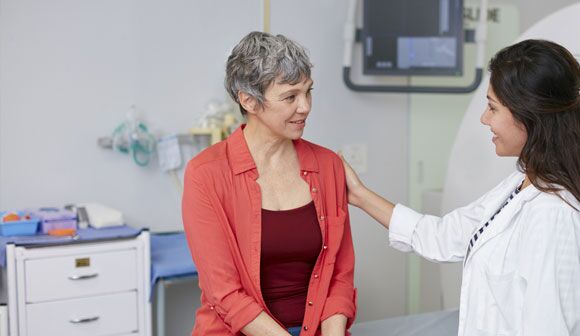At the 2019 AACR Annual Meeting, researchers discussed the landscape of breast cancer treatment highlighting the successes, challenges and promising innovations.
Breast cancer deaths have declined dramatically in recent decades and are nearly 40 percent below their peak in the late 1980s. While this trend may be partially attributed to improvements in screening and early detection, treatment advances play an even larger role.
At the 2019 AACR Annual Meeting, BCRF investigator and outgoing president of AACR Dr. Elizabeth Jaffee chaired a session where breast cancer experts discussed the landscape of treatments for breast cancer subtypes and emerging therapies in clinical trials or in development.
Estrogen receptor-positive (ER) breast cancer. ER-positive breast cancers are the most common and the most treatable form of breast cancer. ER-targeting therapies have played a major role in reducing deaths from this disease with with 95 percent of women with early stage ER-positive surviving more than five years since their diagnosis.
The challenge with ER-positive breast cancer, however, is that these breast cancers can come back years after ostensibly curative treatment. Recurrent ER-positive breast cancers are less likely to respond to the same therapy that was used to treat the primary breast cancer.
In recent years, we’ve seen the emergence of the CDK 4/6 inhibitors (palbociclib, ribociclib and abemaciclib) for metastatic ER-positive breast cancers. While these targeted therapies have dramatically improved survival for many patients, they don’t work for everyone and may stop working for those who received an initial benefit. Efforts are ongoing to identify new combination approaches to improve response to CDK 4/6 inhibitors including new estrogen receptor – and androgen receptor-targeted therapies, novel drug designs, and new CDK-directed therapies.
HER2-positive breast cancer. For many years, breast cancers that were driven by the HER2 oncogene were considered lethal. The discovery of trastuzumab (Herceptin®) revolutionized treatment for HER2-positive breast cancers but not every patient receives the same benefit.
Since the discovery of trastuzumab, other HER2-targeting agents have emerged and now combination approaches using dual HER2 agents and chemotherapy are common. One of the challenges in the clinical management of HER2-positive breast cancer is knowing which patients diagnosed with early-stage disease need aggressive, i.e. dual targeted therapy or added chemotherapy, and which do not. Both of these scenarios come with added toxicity and significant cost (in the case of adding a second HER2 agent).
Unlike ER-positive disease in which doctors can utilize results from the genomic test: Oncotype DX™ to determine the efficacy of chemotherapy for a particular patient, HER2-positive disease doesn’t have a similar test to guide treatment decisions.
Neoadjuvant therapy (therapy delivered before surgery) has emerged as a way to gauge the aggressiveness of a HER2-positive breast cancer. For patients whose tumor responds well to neoadjuvant therapy, a less aggressive treatment regimen may be all that is needed. While those whose tumors do not respond, may require more aggressive treatment.
In addition to personalizing the approach to treatment in HER2-positive breast cancer, new drug designs including drug-antibody conjugates, such as ado-trastuzumab emtansine (T-DM1) are improving the precision and effectiveness of HER2-targeted therapy.
Triple negative breast cancer (TNBC). Triple negative breast cancers are so named because they lack estrogen, progesterone and HER2 receptors. Combination chemotherapy is still the standard treatment for early-stage TNBC, and many patients respond well to this approach. As in HER2-positive breast cancer, the tumor’s response to neoadjuvant therapy can inform subsequent adjuvant therapy.
Recent results from tumor profiling studies have shown that TNBC is a family of breast cancers and this is opening the doors to new targeted approaches to benefit patients with certain types of TNBC:
– Immunotherapy: Early this year, the FDA approved the first immunotherapy for HER2 negative breast cancer, specifically for patients with advanced triple negative breast cancer. Results from the IMpassion 130 trial demonstrated a significant benefit of atezolizumab, a drug that targets a protein called PD-L1. Again, not all patients benefit from this therapy and efforts continue to improve immunotherapy for TNBC, including vaccine development, combination immune- and immune enhancing therapies. Read more about the IMpassion130 trial in our earlier blog featuring an interview with Dr. Leisha Emens.
– PARP inhibitors: Last year, the FDA approved the first PARP inhibitor, olaparib, for TNBC that are driven by mutations in the BRCA1 or BRCA2 genes. Most breast cancers caused by inherited BRCA mutations are the triple negative subtype. Mutations in these genes cause a defect in a type of DNA repair called homologous recombination (HR). This defect makes the cell dependent on a backup DNA repair process that is regulated by a protein called PARP (Poly (ADP-ribose) polymerase). Combining a PARP inhibitor with DNA damaging chemotherapy kills cells that harbor mutations in the BRCA genes. Efforts are ongoing to understand why some tumors respond to this approach and others don’t, or why tumors become resistant. This is opening the door to new strategies including immunotherapy combinations with PARP inhibitor therapy.
– Selected Androgen Receptor modulators (SARMs): While the androgen receptor (AR) emerged as a target in prostate cancer, it is not uncommon to find AR on TNBC tumors. Clinical and laboratory studies are ongoing to test the efficacy of AR inhibitors for some patient with TNBC.







